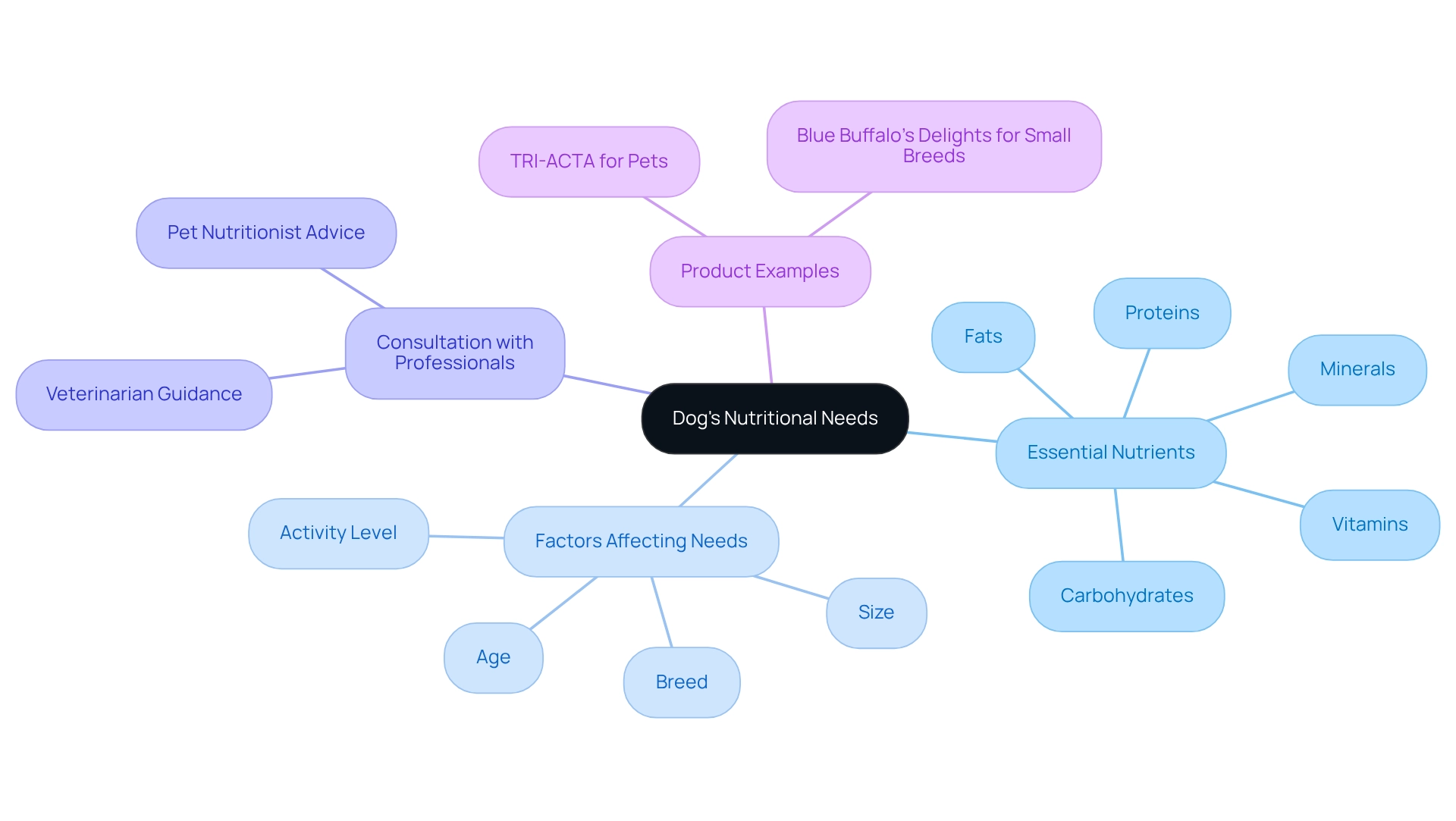Can Dogs Eat Asparagus? Steps for Safe Introduction
Overview
As a loving pet owner, you may wonder about the safety of introducing asparagus to your furry family member’s diet. The good news is that dogs can enjoy asparagus when it’s prepared safely and offered in moderation. This nutritious vegetable provides essential vitamins and dietary fiber that can support their overall health.
At Adventure Den, we understand your concerns about pet care. That’s why we emphasize the importance of careful preparation and gradual introduction of new foods. To minimize the risk of gastrointestinal distress, consider:
- Cooking the asparagus
- Cutting it into small pieces
- Closely monitoring your pet for any adverse reactions
By taking these steps, you can ensure a positive experience for your beloved companion.
Remember, nurturing your pet’s well-being is our priority. With the right approach, asparagus can be a healthy addition to their diet, bringing variety and nutrition. If you have any questions or need guidance, don’t hesitate to reach out. We’re here to support you and your furry family members every step of the way.
Introduction
Navigating the world of canine nutrition can feel like a complex journey for loving pet owners, especially when considering the introduction of new foods like asparagus. It’s important to understand your dog’s unique dietary requirements, as these needs can vary widely based on factors such as age, breed, and activity level.
While asparagus is packed with vitamins and fiber, it also carries potential risks if not prepared and introduced correctly. This article gently guides you through the essential steps for safely incorporating asparagus into your dog’s diet, exploring its benefits and risks along the way.
Additionally, we provide valuable resources for pet owners who are eager to enhance their furry family members’ nutritional health. By approaching this topic with care and knowledge, you can ensure your pets enjoy a balanced and healthy diet that promotes their longevity and well-being.
Understand Your Dog’s Nutritional Needs
Before introducing asparagus or any new food into your dog’s meals, it’s essential to understand if can dogs eat asparagus and their nutritional needs. A balanced nutrition plan for your furry family member should include proteins, fats, carbohydrates, vitamins, and minerals. These requirements can vary widely based on factors such as age, size, breed, and activity level. For instance, active dogs typically need higher protein and calorie intake compared to their less active counterparts.
Additionally, trace amounts of glucosamine and chondroitin can support your dog’s mobility, emphasizing the significance of certain nutrients in their diet. Consulting with a veterinarian or a pet nutritionist is crucial to determine your dog’s specific dietary needs, especially when considering if can dogs eat asparagus fits into their overall nutritional plan. As noted by Integricare, “TRI-ACTA for pets provides you with pure, therapeutic ingredients you can rely on, backed by over two decades of experience.”
This understanding empowers you to make informed choices regarding your dog’s nutrition and health, nurturing their well-being and longevity. For example, a case study assessing Blue Buffalo’s Delights for Small Breeds illustrates that this product is suitable for small canines with dental issues, offering a grain-free and nutritious alternative that meets their dietary requirements.
By taking a comprehensive approach to understanding dog nutrition, you can help ensure that your furry family member thrives.

Explore the Benefits and Risks of Asparagus for Dogs
When prepared with care, asparagus can be a wonderful and nutritious enhancement to your furry family member’s meals, prompting the question: can dogs eat asparagus? This vibrant vegetable is rich in essential vitamins A, C, E, and K, along with dietary fiber, which supports healthy digestion. However, it’s important to keep a few considerations in mind. Raw vegetable stalks can be challenging for pets to chew, potentially leading to gastrointestinal distress if introduced too quickly or in large amounts. It’s crucial to monitor your dog for any adverse reactions after introducing new foods.
As veterinarians often advise, “By slowly introducing new food in this way, you may reduce the chances of your pet suffering from significant digestive upset if they have problems digesting that food or develop an allergic reaction to it.” For dogs with a history of digestive issues, it’s a wise choice to consult a veterinarian to determine if can dogs eat asparagus before incorporating this vegetable into their diet. By gradually adding asparagus and observing your pet’s response, you can help minimize the risk of digestive discomfort, ensuring a nurturing environment for your beloved companion.

Follow Steps to Safely Introduce Asparagus to Your Dog
To safely introduce this vegetable to your furry family member, follow these nurturing steps:
- Choose Fresh Produce: Opt for fresh, organic green stalks to minimize exposure to pesticides and chemicals.
- Wash Thoroughly: Rinse the vegetable under cold water to eliminate any dirt or residues.
- Prepare the Vegetable: Boil or steam the green stalks until they become soft. Remember, refrain from adding oils, butter, or seasonings, as these can be harmful to dogs.
- Cut into Small Pieces: After cooking, chop the vegetable into small, bite-sized pieces to prevent choking hazards.
- Start with a Small Amount: Introduce a small piece of vegetable to your dog initially. Monitor for any signs of digestive upset, such as vomiting or diarrhea. According to Emilie Bess, a Ph.D. biologist, starting with small portions is crucial when introducing any new food to a dog’s diet.
- Slowly Expand Portion Size: If your dog handles the vegetable well, you can gradually increase the quantity over time, ensuring it remains a small part of their overall nutrition. It’s vital to maintain a balanced nutritional intake; for example, We Feed Raw’s patties consist of around 80% muscle meat, emphasizing the necessity for nutritional equilibrium when introducing new foods.
- Observe for Reactions: Always keep an eye out for any adverse reactions after feeding the vegetable, and consult your veterinarian if you notice any concerning symptoms. A case study involving homemade dog treats highlights the significance of ensuring safety in food preparation, reinforcing the necessity for caution when adding new foods, especially regarding the question of can dogs eat asparagus. As We Feed Raw states, their cold-pressure process inactivates potential pathogens, underscoring the importance of food safety in your dog’s diet.

Access Resources for Dog Nutrition and Care
For comprehensive information on dog nutrition and care, we invite you to explore these trusted resources that can support you in nurturing your furry family members:
- American Kennel Club (AKC): This organization provides a wealth of articles focused on dog nutrition and health, making it a go-to source for pet owners seeking reliable guidance.
- PetMD: Renowned for its expert-reviewed material, PetMD addresses a broad array of pet health subjects, including vital nutritional guidance for canines.
- VCA Animal Hospitals: This resource offers detailed guidelines on the general feeding and nutritional needs of dogs, ensuring that pet owners can make informed decisions.
- ASPCA: The ASPCA provides valuable tips on dog care, including dietary recommendations and lists of safe foods for pets.
- Your Veterinarian: Always consult your veterinarian for personalized advice tailored to your dog’s specific health needs, as they can provide insights based on your pet’s unique circumstances.
At Adventure Den, we prioritize the well-being of every dog in our care, ensuring they receive not only a safe and engaging environment but also guidance on proper nutrition. By utilizing these resources, pet owners can enhance their understanding of dog nutrition and make informed choices that align with the exceptional care provided at our facility. Together, we can create a nurturing environment where your beloved pets thrive.

Conclusion
Introducing asparagus into your dog’s diet can be a rewarding experience, especially when approached with care and understanding. Recognizing your dog’s unique nutritional needs is the first step toward ensuring they enjoy a balanced diet that supports their overall health. Each furry family member is different, with age, breed, and activity level influencing their dietary requirements.
Asparagus brings a wealth of health benefits, including essential vitamins and fiber, yet it’s important to be mindful of its potential risks. By preparing it properly and introducing it gradually, you can help minimize any adverse reactions, allowing your dog to safely enjoy this nutritious vegetable. Following the outlined steps for safe incorporation will empower you to avoid common pitfalls, enhancing your dog’s diet in a nurturing way.
Lastly, turning to reputable resources for dog nutrition and care equips you to make informed decisions. Consulting experts and utilizing trusted guides can help you navigate the complexities of canine nutrition effectively. With thoughtful consideration and careful planning, asparagus can become a beneficial addition to your dog’s meal plan, contributing to their well-being and longevity. Remember, your commitment to their health creates a nurturing environment where they can thrive.
Frequently Asked Questions
Can dogs eat asparagus?
Before introducing asparagus or any new food into your dog’s meals, it’s essential to understand their nutritional needs and consult with a veterinarian or pet nutritionist to determine if asparagus fits into their overall diet.
What are the nutritional needs of dogs?
A balanced nutrition plan for dogs should include proteins, fats, carbohydrates, vitamins, and minerals. These requirements can vary based on factors such as age, size, breed, and activity level.
How do activity levels affect a dog’s dietary needs?
Active dogs typically require higher protein and calorie intake compared to less active dogs.
What specific nutrients can support a dog’s mobility?
Trace amounts of glucosamine and chondroitin can support a dog’s mobility, highlighting the importance of certain nutrients in their diet.
Why is it important to consult with a veterinarian or pet nutritionist?
Consulting with a veterinarian or pet nutritionist is crucial to determine your dog’s specific dietary needs, especially when considering new foods like asparagus.
What is an example of a suitable dog food for small breeds?
Blue Buffalo’s Delights for Small Breeds is an example of a suitable product, offering a grain-free and nutritious alternative that meets the dietary requirements of small canines with dental issues.
How can understanding dog nutrition benefit my pet?
A comprehensive understanding of dog nutrition empowers you to make informed choices regarding your dog’s diet, which can help ensure their well-being and longevity.

